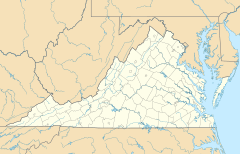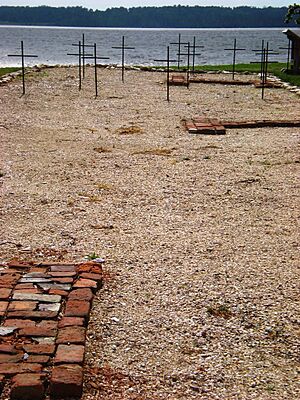Jamestown, Virginia facts for kids
Quick facts for kids
Jamestown, Virginia
Jamestowne, Williamsburg
|
|
|---|---|
|
Fort (1607) and Town (1619)
|
|
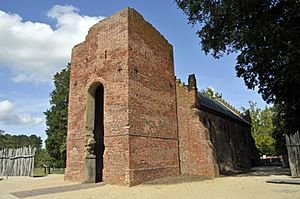
The ruined tower of the 17th century Jamestown Church; the nave was reconstructed in 1907 on its original foundations
|
|
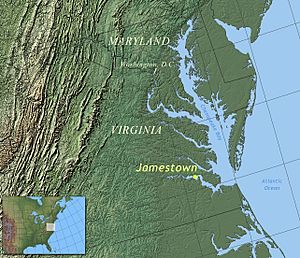
Location of Jamestown in Virginia
|
|
| Colony | Colony of Virginia |
| Established | May 14, 1607 |
| Abandoned | Briefly in 1610; again after 1699 |
| Founded by | London Company |
| Named for | James I |
Jamestown was the first permanent English settlement in the Americas. It was located in the Colony of Virginia, on the northeast bank of the James River. Today, it's about 4 kilometers (2.5 miles) southwest of Williamsburg.
The London Company established Jamestown as "James Fort" on May 14, 1607. It became the colonial capital from 1616 until 1699. Early years were very tough. More than 80% of the colonists died in 1609–1610 from hunger and sickness. The survivors briefly left Jamestown in 1610 but returned after meeting new supply ships.
In August 1619, the first recorded Africans arrived near Jamestown. They had been taken from a Portuguese slave ship by British sailors. These 20 or so Africans, from what is now Angola, likely worked in the tobacco fields. This was the beginning of a system that later became formal slavery in the British colonies.
Jamestown was burned during Bacon's Rebellion in 1676 but was rebuilt. In 1699, the capital moved to what is now Williamsburg. Jamestown then became an archaeological site. Today, it's part of the Historic Triangle of Colonial Virginia, along with Williamsburg and Yorktown.
Contents
Founding the Jamestown Colony
The English were slower than other European countries to start colonies in the New World. Early attempts, like the Roanoke Colony, failed. But in 1606, English colonists set sail with a plan to create a new settlement.
Journey to the New World
The London Company gave the colonists a special paper, called a charter, to start a colony. Their fleet had three ships: the Susan Constant, Discovery, and Godspeed. Captain Christopher Newport led the journey.
Their trip was long, lasting four months. They stopped in the Canary Islands and Puerto Rico. On April 26, 1607, they finally landed in America at a place they named Cape Henry.
Choosing the Jamestown Site
The colonists needed a safe place for their settlement. They explored the area and found a river they named the James River, after King James I of England. On May 14, 1607, they chose a spot on a large peninsula.
This location was good for defense because of a curve in the river. It was also close to the land, making it easy for ships to dock. The area was empty because local Native American groups thought it was too swampy and not good for farming.
However, the island had problems. It was swampy, full of mosquitoes, and the river water was salty and not good for drinking.
Early Challenges and Hardships
The settlers arrived during a very bad drought, the worst in 700 years. This made it hard to grow food and find fresh water. Many colonists were gentlemen or their servants, not used to hard work.
Two-thirds of the settlers died before new supplies arrived in 1608. These ships brought more people, including German and Polish craftsmen. These skilled workers helped start the first factories in the colony. For example, glassware became an important product sent back to England.
Some Germans even left the colony and joined the Powhatan people. They tried to get the Powhatans to join a rumored Spanish attack. But Captain Samuel Argall arrived in July 1609, stopping the Spanish from learning how weak the colony was.
The investors in London were not happy. They wanted gold and other valuable goods from the colony. Captain John Smith, who became the colony's leader, told them they needed to send practical workers, not just gentlemen.
The Starving Time (1609–1610)
After John Smith was injured and had to return to England, George Percy led the colony. He was not good at dealing with the Native American tribes. London sent a large supply mission in 1609, led by Captain Christopher Newport on a new ship called Sea Venture.
On June 2, 1609, Sea Venture sailed with 214 settlers. A strong storm, probably a hurricane, hit the fleet. The Sea Venture was badly damaged, and its admiral, Sir George Somers, purposely steered it onto the reefs of Bermuda to save everyone.
The survivors were stuck in Bermuda for nine months. They built two new ships, Deliverance and Patience. Meanwhile, Jamestown faced its worst period, known as the Starving Time. There was almost no food. People suffered from extreme hunger and took desperate measures to survive. Only 60 of the 214 settlers at Jamestown lived through this time.
The ships from Bermuda finally arrived in Jamestown on May 23, 1610. The colony was in terrible shape. The survivors decided to leave Jamestown and sail for England. But on June 10, 1610, another relief fleet arrived, led by Governor Thomas West, 3rd Baron De La Warr. This arrival saved Jamestown, and the colonists returned. They called this The Day of Providence.
After Governor De La Warr arrived, relations with the Powhatan people got worse. This led to the Anglo-Powhatan Wars. The war ended when Samuel Argall captured Pocahontas, the daughter of Chief Wahunsenacawh. This led to a peace treaty.
Growth and Challenges
The first few years of Jamestown were difficult. But things started to improve.
Tobacco and New Beginnings
John Rolfe was one of the colonists who survived the Starving Time. He brought special tobacco seeds from Bermuda. In 1614, Rolfe successfully grew and harvested tobacco. This crop became very important for the colony's economy.
Rolfe married Pocahontas, which brought several years of peace between the English and the Native Americans. Sadly, Pocahontas died in England in 1617. Her father, Chief Powhatan, died the next year. His brother, Opechancanough, became the new leader of the Powhatan Confederacy. As the English took more land for tobacco farms, relations with the Native Americans worsened again.
Many English settlers came to Jamestown as indentured servants. They agreed to work for three to seven years in exchange for their trip, food, and a promise of land or money.
First Assembly and African Arrivals
In 1619, the first representative assembly in America, the General Assembly, met in the Jamestown Church. This was a big step towards self-government. At first, only English men could vote. But Polish craftsmen protested and were granted equal voting rights on July 21, 1619.
Also in August 1619, the first documented Africans arrived in English North America on a ship called White Lion. An African man and woman, later named Antoney and Isabella, were among them. They became the first African family recorded in Jamestown. Their baby, William Tucker, was the first documented African child baptized in British North America.
The 1622 Attack
After years of uneasy peace, Chief Opechancanough and his Powhatan Confederacy tried to destroy the English colony. On March 22, 1622, they attacked farms and communities along the James River. This event is known as the Indian massacre of 1622. More than 300 settlers were killed, about one-third of the English population. Jamestown itself was saved by a warning from a Native American worker.
Between 1608 and 1624, about 6,000 people came to Jamestown. Only 3,400 of them survived.
Later Years and Preservation
In 1624, King James took away the Virginia Company's charter, and Virginia became a royal colony ruled by the King. The colony kept growing.
Moving the Capital
Another large Native American attack happened in 1644. In 1646, Opechancanough was captured and killed. The Powhatan Confederacy then began to lose power. Peace treaties were signed, requiring the Powhatan to pay tribute and live on reservations.
In 1676, during Bacon's Rebellion, Jamestown was burned down. It was rebuilt, but the Virginia government started meeting in other places. When the statehouse burned again in 1698, the capital was permanently moved to Middle Plantation. This town was renamed Williamsburg in 1699, honoring King William III.
After the capital moved, Jamestown slowly declined. By the mid-1700s, the church was abandoned, and the land was mostly used for farming.
Saving Jamestown's History
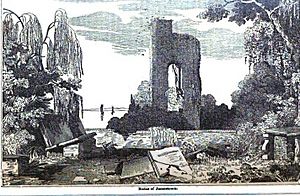
During the American Civil War in 1861, Confederate troops occupied Jamestown Island. They tried to block the James River from the Union Navy. In 1862, Union forces captured nearby Yorktown and Williamsburg, so the Confederates left Jamestown.
Jamestown then became a meeting place for runaway slaves. After the war, in 1892, Edward Barney bought Jamestown. The next year, he gave 22.5 acres of land, including the old church tower, to Preservation Virginia. People thought the original fort was underwater due to erosion. A sea wall was built in 1900 to protect the land.
In 1996, the Jamestown Rediscovery project began digging to find the original 1607 James Fort. They found the remains of the fort, which had been protected by the sea wall.
Today, Colonial National Historical Park includes Jamestown Island. It has two main sites for visitors:
- Historic Jamestowne: This is the actual site of the original 1607 fort and 17th-century town. Visitors can see the archaeological digs, the old church tower, and a museum called the Archaearium. Archaeologists are still working here, finding millions of artifacts.
- Jamestown Settlement: This is a living-history museum about 2 kilometers (1.25 miles) from the original site. It has a reconstructed Powhatan village, a replica of James Fort from around 1610–1614, and full-sized replicas of the three ships that brought the first settlers: Susan Constant, Godspeed, and Discovery.
Celebrating Jamestown's Legacy
Jamestown's founding in 1607 has been celebrated many times, especially every fifty years.
Big Anniversaries
- 200th Anniversary (1807): Called the Grand National Jubilee, over 3,000 people attended. There were speeches, dinners, and performances.
- 250th Anniversary (1857): Between 6,000 and 8,000 people came. Former US President John Tyler gave a long speech. There were military displays, a ball, and fireworks.
- 300th Anniversary (1907): Jamestown Exposition: This was a huge international fair held near Norfolk, not on Jamestown Island itself. It was too hard to get large crowds to the island back then. Many important people attended, including US President Theodore Roosevelt and the German Kaiser.
- 350th Anniversary (1957): Jamestown Festival: This celebration was held at Jamestown itself. New roads and attractions were built. Replicas of the three original ships were made. Queen Elizabeth II of the United Kingdom and Prince Philip visited, which was a big highlight.
- 400th Anniversary (2007): Jamestown 2007: This included 18 months of events. Queen Elizabeth II and Prince Philip visited again. The US Mint released special coins to honor the anniversary.
- 2019 Commemoration: Jamestown and Williamsburg marked 400 years since three key events: the first General Assembly meeting, the arrival of the first Africans, and the first Thanksgiving.
Jamestown in Pop Culture
Jamestown's story has appeared in many books and movies:
- The novel To Have and to Hold (1900) is a romantic adventure set in Jamestown. It was made into two films.
- The Disney animated film Pocahontas (1995) and its sequel show a fictional version of Jamestown.
- The film The New World (2005) tells the story of Jamestown's colonization. It focuses on the relationship between John Smith and Pocahontas.
- First Landing: The Voyage from England to Jamestown (2007) is another film about the colonists' journey.
- The TV series Jamestown (2017) is set in the colony and explores the changes after women arrive.
- In the TV series For All Mankind, a fictional lunar base is named after Jamestown.
See also
 In Spanish: Jamestown (Virginia) para niños
In Spanish: Jamestown (Virginia) para niños


